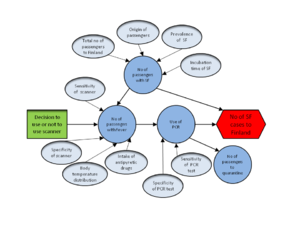User:Mari Malinen
Homework 1
What is shared understanding?
- All participants understand what decision options are considered, desired outcomes, objectives, facts, opinions and disagreements exist and why. Also why a certain decision option is selected.
- Everyone understands the whole picture without having to agree with each other.
What different purposes are there for participation in assessment and/or decision making?
- Openness builds trust among participants and outside observers.
- To make sure all relevant issues are raised and handled properly
- Through successful critique invalid statements can be ruled out from the assessment
What is benefit-risk assessment?
- Analyzing different scientific data to compare benefits and risks of an event, activity, food etc.
- For example assessing use of food additives: do the benefits outweigh possible risks?
←--#: . OK. --Jouni (talk) 10:09, 23 March 2015 (UTC) (type: truth; paradigms: science: defence)
Homework 2
- What could an Universal object be in an assessment?
- Is the Training assessment similar to the assignment we are going to do during the course?
DARM 2015 Homework 4
| Moderator:ADD YOUR USERNAME (see all) |
| This page is a stub. You may improve it into a full page. |
| Upload data
|
Scope
Question
- What measures can be taken in Helsinki Metropolitan area to control climate change by reducing greenhouse gas emissions?
- How to reduce the per capita carbon dioxide emissions of the Helsinki Metropolitan Area by 39 per cent of the 1990 level by the year 2030?
Intended use and users
Helsinki Metropolitan area city authorities
Participants
- Cities of Helsinki, Espoo, Vantaa and Kauniainen
- A broad range of environmental protection, planning, traffic and public transport specialists from the cities
- YTV specialists in traffic, solid waste management and regional development
- representatives of energy companies
- interest groups
Boundaries
- Area: Helsinki Metropolitan area (Helsinki, Espoo, Vantaa and Kauniainen)
- Time: Based on years 1990, 2000 and 2004. Estimations made for year 2030.
- Considered sources of GHG emissions:
- Electric heating
- consumption electric power
- transport, district heating
- separate heating
- industry and machinery
- treatment of solid waste and waste water
Decisions and scenarios
Three considered scenarios
- Business as usual
- Reducing GHG emissions 39 % from the 1990 emission level
- Continued rapid growth in electricity consumption
Timing
Answer
Results
Conclusions
Rationale
Upload a causal diagram and change the right name here.

Stakeholders
Dependencies
Analyses
Indices
Calculations
See also
Keywords
References